
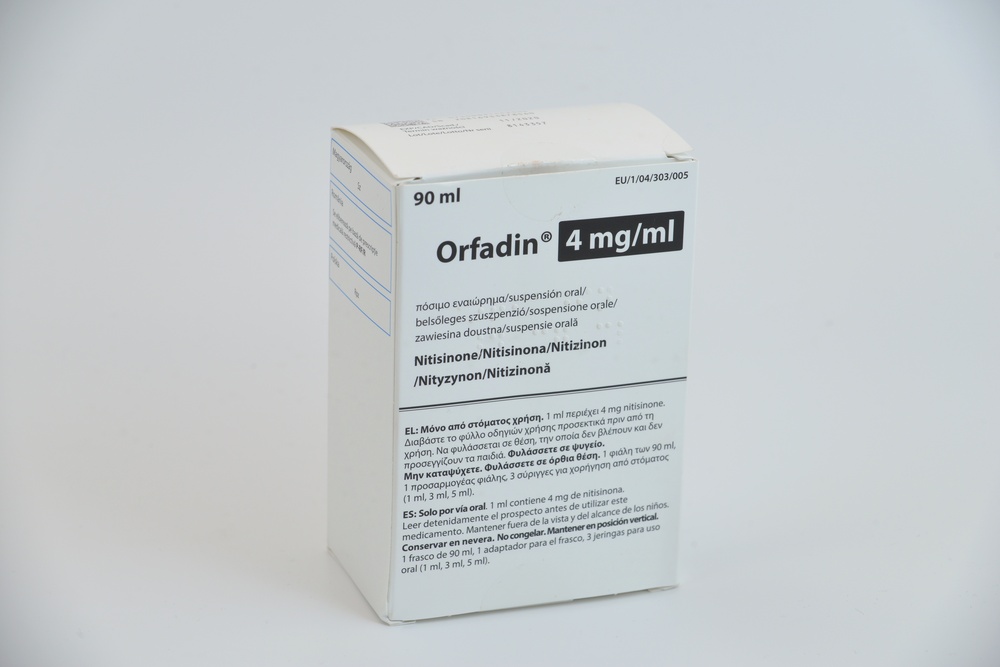
ORFADIN 4 mg/ml SUSPENSÃO ORAL

Pergunte a um médico sobre a prescrição de ORFADIN 4 mg/ml SUSPENSÃO ORAL

Como usar ORFADIN 4 mg/ml SUSPENSÃO ORAL
Introdução
Prospecto: informação para o utilizador
Orfadin 2 mg cápsulas duras
Orfadin 5 mg cápsulas duras
Orfadin 10 mg cápsulas duras
Orfadin 20 mg cápsulas duras
nitisinona
Leia todo o prospecto detenidamente antes de começar a tomar o medicamento, porque contém informações importantes para si.
- Conserva este prospecto, porque pode ter que voltar a lê-lo.
- Se tiver alguma dúvida, consulte o seu médico, farmacêutico ou enfermeiro.
- Este medicamento foi-lhe prescrito apenas para si, e não deve dá-lo a outras pessoas, mesmo que tenham os mesmos sintomas que si, porque pode prejudicá-las.
- Se experimentar efeitos adversos, consulte o seu médico, farmacêutico ou enfermeiro, mesmo que se trate de efeitos adversos que não aparecem neste prospecto. Ver secção 4.
Conteúdo do prospecto
- O que é Orfadin e para que é utilizado
- O que precisa saber antes de começar a tomar Orfadin
- Como tomar Orfadin
- Posíveis efeitos adversos
- Conservação de Orfadin
- Conteúdo do envase e informação adicional
1. O que é Orfadin e para que é utilizado
Orfadin contém o princípio ativo nitisinona. Orfadin é utilizado para tratar:
- uma doença rara denominada tirosinemia hereditária tipo 1 em adultos, adolescentes e crianças (de qualquer intervalo de idade).
- uma doença rara denominada alcaptonúria (AKU) em adultos
Nestas doenças, o seu organismo não consegue degradar totally o aminoácido tirosina (os aminoácidos são os elementos fundamentais das proteínas), formando-se substâncias tóxicas. Estas substâncias acumulam-se no seu organismo. Orfadin bloqueia a degradação da tirosina, e as substâncias tóxicas não se formam.
Para o tratamento da tirosinemia hereditária tipo 1, deve seguir uma dieta especial enquanto tomar este medicamento, porque a tirosina seguirá estando no seu organismo. Dita dieta baseia-se num baixo conteúdo de tirosina e fenilalanina (outro aminoácido).
Para o tratamento da AKU, o seu médico poderá aconselhá-lo a seguir uma dieta especial.
2. O que precisa saber antes de começar a tomar Orfadin
Não tome Orfadin
- se é alérgico à nitisinona ou a qualquer um dos outros componentes deste medicamento (incluídos na secção 6).
Não amamente enquanto estiver a tomar este medicamento (ver secção “Gravidez e amamentação”).
Advertências e precauções
Consulte o seu médico ou farmacêutico antes de começar a tomar Orfadin.
- Um oftalmologista irá examinar os seus olhos antes do tratamento e de forma regular durante o tratamento com nitisinona. Se notar vermelhidão nos olhos ou se notar qualquer outro efeito nos olhos, contacte imediatamente o seu médico para que lhe faça um exame oftalmológico. Os problemas oculares (ver secção 4) podem ser um indicio de um controlo inadequado da dieta.
Durante o tratamento, serão retiradas amostras de sangue para controlar se o tratamento é o adequado e para garantir que não existem efeitos secundários causantes de alterações sanguíneas.
Se receber Orfadin para o tratamento da tirosinemia hereditária tipo 1, serão feitos controles hepáticos periódicos porque a doença afeta o fígado.
O seu médico deve realizar um acompanhamento cada 6 meses. Se sofrer algum efeito adverso, é recomendável utilizar intervalos de tempo mais curtos.
Outros medicamentos e Orfadin
Informa o seu médico ou farmacêutico se está a tomar, tomou recentemente ou poderá ter que tomar qualquer outro medicamento.
Orfadin pode interferir com o efeito de outros medicamentos, tais como:
- medicamentos para a epilepsia (como a fenitoína)
- medicamentos contra a formação de coágulos de sangue (como a warfarina)
Uso de Orfadin com alimentos
Recomenda-se tomar a suspensão oral juntamente com alimentos.
Gravidez e amamentação
Não se estudou a segurança deste medicamento em mulheres grávidas e em mulheres que amamentam.
Consulte o seu médico se tem previsto ficar grávida. Se ficar grávida, deve consultar o seu médico imediatamente.
Não amamente enquanto estiver a tomar este medicamento (ver secção “Não tome Orfadin”).
Condução e uso de máquinas
A influência deste medicamento sobre a capacidade para conduzir e utilizar máquinas é pequena. No entanto, se experimentar efeitos adversos que afetem a visão, não deve conduzir nem utilizar máquinas até que a sua visão tenha voltado à normalidade (ver secção 4 “Posíveis efeitos adversos”).
Orfadin contém sódio, glicerol e benzoato de sódio
Este medicamento contém 0,7 mg (0,03 mmol) de sódio por ml.
Uma dose de 20 ml de suspensão oral (10 g de glicerol) ou mais pode provocar dor de cabeça, molestias de estômago e diarreia.
O benzoato de sódio pode aumentar a icterícia (coloração amarela da pele e dos olhos) nos neonatos ictéricos prematuros ou nascidos a termo e derivar em kerníctero (dano cerebral causado por depósitos de bilirrubina no cérebro). Nos recém-nascidos, os níveis de bilirrubina no sangue (uma substância que a altas concentrações causa a coloração amarela da pele) devem ser controlados estritamente. Se os níveis forem marcadamente mais elevados do que deviam, especialmente em bebês prematuros com fatores de risco como acidose (pH do sangue demasiado baixo) ou baixa concentração de albúmina (uma proteína do sangue), deve-se considerar o tratamento com Orfadin cápsulas em vez da suspensão oral até que as concentrações plasmáticas de bilirrubina se tenham normalizado.
3. Como tomar Orfadin
Siga exatamente as instruções de administração do medicamento indicadas pelo seu médico. Em caso de dúvida, pergunte ao seu médico ou farmacêutico.
Siga cuidadosamente as instruções facilitadas a continuação sobre preparação e administração da dose para se certificar de que se administra a dose correcta.
Para a tirosinemia hereditária tipo 1, o tratamento com este medicamento deve ser iniciado e supervisionado por um médico com experiência no tratamento da doença (tirosinemia hereditária tipo 1).
Para a tirosinemia hereditária tipo 1, a dose recomendada diária é 1 mg/kg de peso corporal administrada por via oral. O seu médico ajustará a dose individualmente.
Recomenda-se administrar a dose uma vez ao dia. No entanto, devido a que os dados são limitados nos pacientes com um peso corporal <20 kg, nesta população de pacientes recomenda-se dividir a dose diária total em duas tomas ao dia.< p>
Para a AKU, a dose recomendada é 10 mg uma vez ao dia.
A suspensão oral deve ser administrada directamente na boca sem diluir mediante a seringa para uso oral.
Orfadin não se deve injectar. Não acople uma agulha à seringa.
Como preparar a dose que se deve administrar
A dose prescrita pelo seu médico deve ser administrada em ml de suspensãoe não em mg. Isto é assim porque a seringa para uso oral que se deve utilizar para extrair do frasco a dose correcta do produto está marcada em ml. Se a sua receita está em mg, contacte o seu médico ou farmacêutico para que lhe aconselhe.
O envase contém um frasco de medicamento com uma cápsula de fecho, um adaptador para o frasco e três seringas para uso oral (1 ml, 3 ml e 5 ml) Utilize sempre estas seringas para uso oral para tomar o medicamento.
- A seringa para uso oral de 1 ml (a mais pequena) está graduada entre 0,1 ml e 1 ml mediante pequenas marcas de 0,01 ml. Utiliza-se para medir doses de até 1 ml.
- A seringa para uso oral de 3 ml (a mediana) está graduada entre 1 ml e 3 ml mediante pequenas marcas de 0,1 ml. Utiliza-se para medir doses de mais de 1 ml e até 3 ml.
- A seringa para uso oral de 5 ml (a mais grande) está graduada entre 1 ml e 5 ml mediante pequenas marcas de 0,2 ml. Utiliza-se para medir doses de mais de 3 ml.
É importante que utilize a seringa para uso oral correcta para tomar o medicamento. O seu médico, farmacêutico ou enfermeiro indicar-lhe-á como deve usar a seringa para uso oral em função da dose prescrita.
Como preparar um novo frasco do medicamento para utilizar por primeira vez:
Antes de tomar a primeira dose, deve agitar o frasco vigorosamente, já que durante o armazenamento prolongado as partículas formam um precipitado sólido no fundo do frasco. Siga as instruções descritas a continuação:
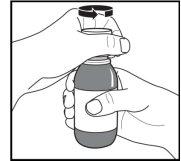
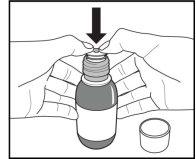

Figura A. Figura B. Figura C.
- Saia o frasco da geladeira e anote a data na etiqueta do frasco.
- Agite o frasco vigorosamente durante pelos menos 20 segundosaté que a torta sólida que há no fundo do frasco se disperse completamente (Figura A).
- Retire o fecho de rosca à prova de crianças; para isso, aperte-o para baixo com força e gire-o em sentido contrário às agulhas do relógio (Figura B).
Coloque o frasco aberto direito em cima da mesa. Empurre com força o adaptador de plástico dentro do pescoço do frasco todo o que puder (Figura C) e feche o frasco com o fecho de rosca à prova de crianças.
Para as doses posteriores, consulte a continuación as instruções “Como preparar uma dose do medicamento”
Como preparar uma dose do medicamento
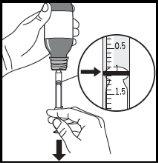
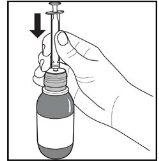
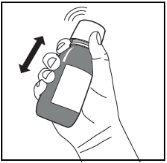
Figura D. Figura E. Figura F.
- Agite o frasco vigorosamente durante pelo menos 5 segundos (Figura D).
- Imediatamente, retire o fecho de rosca à prova de crianças e abra o frasco.
- Empurre até o fundo o êmbolo da seringa para uso oral.
- Mantenha o frasco em posição vertical e insira a seringa para uso oral firmemente no orifício do adaptador situado na parte superior do frasco (Figura E).
- Inverta com cuidado o frasco sem retirar a seringa para uso oral (Figura F).
- Para obter a dose prescrita (ml), puxe o êmbolo lentamentepara baixo até que o bordo superior do anel preto fique nivelado exactamente com a linha que señala a dose (Figura F). Se observar alguma bolha de ar dentro da seringa para uso oral cheia, faça retroceder o êmbolo até que saiam as bolhas. Depois, volte a puxar o êmbolo para baixo até que o bordo superior do anel preto fique nivelado exactamente com a linha que señala a dose.
- Coloque o frasco de novo em posição vertical. Gire suavemente a seringa para uso oral puxando-a para sacá-la do frasco.
- A dose deve ser administrada imediatamente na boca (sem diluir) para evitar que se forme um precipitado na seringa para uso oral. A seringa para uso oral deve ser esvaziada lentamentepara permitir que o paciente engula o produto; se o medicamento sair em um jorro rápido, pode provocar um engasgo.
- Coloque imediatamente o fecho de rosca à prova de crianças. O adaptador do frasco não deve ser retirado.
- O frasco pode ser mantido à temperatura ambiente (não superior a 25 °C).
Limpeza:
Limpe imediatamentea seringa para uso oral com água. Separe o êmbolo do cilindro da seringa e enxágue ambos com água. Sacuda o excesso de água e deixe que a seringa para uso oral se seque desmontada até que tenha que voltar a montá-la para uma nova administração.
Se tomar mais Orfadin do que deve
Se tomou mais quantidade deste medicamento do que devia, comunique-o imediatamente ao seu médico ou farmacêutico.
Se esqueceu de tomar Orfadin
Não tome uma dose dupla para compensar as doses esquecidas. Se esqueceu de tomar uma dose, comunique-o ao seu médico ou farmacêutico.
Se interromper o tratamento com Orfadin
Se estima que a ação do medicamento não é a adequada, comunique-o ao seu médico. Não mude a dose nem suspenda o tratamento sem falar primeiro com o seu médico.
Se tiver alguma dúvida sobre o uso deste medicamento, pergunte ao seu médico ou farmacêutico.
4. Posíveis efeitos adversos
Como todos os medicamentos, este medicamento pode produzir efeitos adversos, embora não todas as pessoas os sofram.
Se notar qualquer efeito adverso relacionado com os olhos, comunique-o imediatamente ao seu médico para que lhe faça um exame oftalmológico. O tratamento com nitisinona aumenta os níveis de tirosina no sangue, que podem causar sintomas relacionados com os olhos. Nos pacientes com tirosinemia hereditária tipo 1, os efeitos adversos oculares frequentes (podem afectar mais de 1 de cada 100 pessoas) devidos aos níveis mais altos de tirosina são inflamação ocular (conjuntivite), opacidade e inflamação da córnea (queratite), sensibilidade à luz (fotofobia) e dor de olhos. A inflamação das pálpebras (blefarite) é um efeito adverso pouco frequente (pode afectar até 1 de cada 100 pessoas).
Nos pacientes com AKU, a irritação dos olhos (queratopatia) e a dor de olhos são efeitos adversos notificados muito frequentemente (podem afectar mais de 1 de cada 10 pessoas).
A continuación se enumeram outros efeitos adversos notificados em pacientes com tirosinemia hereditária tipo 1:
Outros efeitos adversos frequentes
- Diminuição do número de plaquetas (trombocitopenia) e glóbulos brancos (leucopenia), redução de determinados tipos de glóbulos brancos (granulocitopenia).
Outros efeitos adversos pouco frequentes
- aumento do número de glóbulos brancos (leucocitose),
- picar (prurito), inflamação da pele (dermatite exfoliativa), sarpullido.
A continuación se enumeram outros efeitos adversos notificados em pacientes com AKU:
Outros efeitos adversos frequentes
- bronquite,
- pneumonia,
- picar (prurito), sarpullido.
Comunicação de efeitos adversos
Se experimentar qualquer tipo de efeito adverso, consulte o seu médico, farmacêutico ou enfermeiro, mesmo que se trate de possíveis efeitos adversos que não aparecem neste prospecto. Também pode comunicá-los directamente através do sistema nacional de notificação incluído no Apêndice V. Mediante a comunicação de efeitos adversos, pode contribuir para fornecer mais informações sobre a segurança deste medicamento.
5. Conservação de Orfadin
Mantenha este medicamento fora da vista e do alcance das crianças.
Não utilize este medicamento após a data de validade que aparece no frasco e na caixa após “EXP”. A data de validade é o último dia do mês que se indica.
Conservar na geladeira (entre 2 ºC e 8 ºC). Não congelar.
Mantenha o frasco em posição vertical.
Depois da primeira abertura, o medicamento pode ser conservado durante um único período de 2 meses a uma temperatura não superior a 25 ºC, após o qual deve ser deitado fora.
Não se esqueça de anotar no frasco a data em que o sacou da geladeira.
Os medicamentos não devem ser deitados fora pelos esgotos nem para o lixo. Pergunte ao seu farmacêutico como se livrar dos envases e dos medicamentos que já não precisa. Desta forma, ajudará a proteger o meio ambiente.
6. Conteúdo do envase e informação adicional
Composição de Orfadin
- O princípio ativo é nitisinona. Cada ml contém 4 mg de nitisinona.
- Os outros componentes são hipromelosa, glicerol (ver secção 2), polissorbato 80, benzoato de sódio (E211) (ver secção 2), ácido cítrico monohidrato, citrato de sódio (ver secção 2), aroma de fresa (artificial) e água purificada.
Aspecto do produto e conteúdo do envase
A suspensão oral é uma suspensão branca, opaca e ligeiramente viscosa. Antes de agitar o frasco, pode aparecer como uma torta sólida no fundo com um sobrenadante ligeiramente opalescente.
Apresenta-se num frasco de 100 ml de cor âmbar com um fecho de rosca branco à prova de crianças.
Cada frasco contém 90 ml de suspensão oral.
Cada envase contém um frasco, um adaptador para o frasco e 3 seringas para uso oral.
Titular da autorização de comercialização
Swedish Orphan Biovitrum International AB
SE-112 76 Estocolmo
Suécia
Fabricante
Apotek Produktion & Laboratorier AB
Celsiusgatan 43
SE-212 14 Malmö
Suécia
Apotek Produktion & Laboratorier AB
Prismavägen 2
SE-141 75 Kungens Kurva
Suécia
Data da última revisão deste prospecto: 04/2024.
A informação detalhada deste medicamento está disponível na página web da Agência Europeia de Medicamentos: http://www.ema.europa.eu/. Também existem ligações para outras páginas web sobre doenças raras e medicamentos órfãos.
- País de registo
- Substância ativa
- Requer receita médicaSim
- Fabricante
- Esta informação é apenas para referência e não constitui aconselhamento médico. Consulte sempre um médico antes de tomar qualquer medicamento. A Oladoctor não se responsabiliza por decisões médicas baseadas neste conteúdo.
- Alternativas a ORFADIN 4 mg/ml SUSPENSÃO ORALForma farmacêutica: CÁPSULA, 10 mgSubstância ativa: nitisinoneFabricante: Dipharma Arzneimittel GmbhRequer receita médicaForma farmacêutica: CÁPSULA, 2 mgSubstância ativa: nitisinoneFabricante: Dipharma Arzneimittel GmbhRequer receita médicaForma farmacêutica: CÁPSULA, 20 mgSubstância ativa: nitisinoneFabricante: Dipharma Arzneimittel GmbhRequer receita médica
Alternativas a ORFADIN 4 mg/ml SUSPENSÃO ORAL noutros países
As melhores alternativas com o mesmo princípio ativo e efeito terapêutico.
Alternativa a ORFADIN 4 mg/ml SUSPENSÃO ORAL em Ukraine
Médicos online para ORFADIN 4 mg/ml SUSPENSÃO ORAL
Avaliação de posologia, efeitos secundários, interações, contraindicações e renovação da receita de ORFADIN 4 mg/ml SUSPENSÃO ORAL – sujeita a avaliação médica e regras locais.














